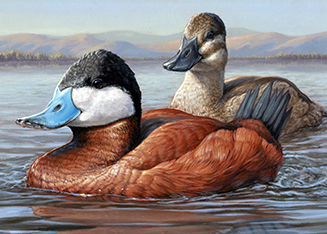Citizen Science
Be a citizen scientist!
Citizen Science is the opportunity for citizens to meaningfully participate in activities sponsored by a variety of organizations and contribute to scientific research. Citizen science is an important contribution to research – it is a partnership between the public and scientists that help answer questions scientists couldn’t possibly collect and answer all on their own.
Citizen science can encompass a broad range of topics, geographic areas, and collection and monitoring strategies. Citizen science projects also create an opportunity for young people to learn about and make a connection to birds and their habitats, gain science skills, and learn more about animal adaptations.
Some Citizen Science projects utilize smartphones and other forms of electronic technology. Anyone who likes to watch birds can participate in a citizen-science project. Think about how you may want to get involved. The list below does not capture all possible projects, but highlights many that vary in the amount of skill required. Choose a project that meets your interests whether in your own yard, city park, schoolyard, or an urban, forest, wetland, or desert environment.
Christmas Bird Count
Audubon
The Christmas Bird Count is one of the oldest citizen science initiatives in North America. Counts occur each year between Wednesday, December 14th and January 5th. Counts take place in a 15 mile wide circle, following a specified route in the circle on a specific day. There are also opportunities to count the birds at your backyard feeder.
www.audubon.org/conservation/science/christmas-bird-count
North American Bird Phenology Program
USGS, Patuxent Wildlife Research Center
Between 1880 and 1970, volunteers recorded information on arrival dates, abundance, and departure
dates of migratory birds across North America. Their observations are a historic collection of six million
cards, illuminating almost a century of migration patterns and population changes. These records are
being scanned and placed on the Internet. Volunteers are needed to transcribe the records and add
them into a database for analysis.
www.pwrc.usgs.gov/bpp/
Neighborhood Nestwatch
Smithsonian Migratory Bird Center
Neighborhood Nestwatch is a citizen science program that teaches residents about the migratory birds
in their backyards, while collecting hard-to-get data about urbanization impacts on wildlife.
http://nationalzoo.si.edu/scbi/migratorybirds/research/neighborhood_nestwatch/
NestWatch
Cornell Lab of Ornithology
Participate in recording the success (or failure) of nesting birds.
http://nestwatch.org/
Report a Banded American Oystercatcher
American Oystercatcher Working Group, Audubon North Carolina, National Fish and Wildlife Federation
Report the location, color, and type of bands you observe on an American Oystercatcher.
amoywg.org
Bird Conservation Network’s Survey (Illinois and Indiana)
Bird Conservation Network
Monitor breeding birds following recommended scientific protocols. Prospective monitors should know common Midwestern birds by sight and sound and be able to make repeated visits to their chosen site.
www.bcnbirds.org
Celebrate Urban Birds
Cornell Lab of Ornithology
Watch and listen for 16 species of birds for 10 minutes in an urban area and then report your observations.
celebrateurbanbirds.org
eBird
Cornell Lab of Ornithology
Report bird sightings into a global online checklist program that gathers information on bird distribution and abundance.
ebird.org/content/ebird/
BirdLog is linked to the eBird citizen science project and provides a tool for users to enter data on bird sightings in the field. Users can upload species sightings into the app and transmit these data to eBird in real-time.
Neighborhood Bird Project (Washington)
Seattle Audubon Society
Every month on the same day, conduct surveys on urban bird species at eight city parks in Seattle.
www.seattleaudubon.org/sas/WhatWeDo/Science/CitizenScience/NeighborhoodBirdProject.aspx
Report a California Condor Sighting
Zoological Society of San Diego
Report and describe sightings of California Condors.
cacondorconservation.org/did-you-see-a-california-condor-let-us-know/
YardMap
Cornell Lab of Ornithology
Draw a map of your backyard, park, farm, favorite birding location, school, or garden to cultivate a richer understanding of bird habitats.
yardmap.org
Report a Banded Sandhill Crane
International Crane Foundation
Report sightings of Sandhill Cranes wearing colored leg bands.
www.savingcranes.org/banded-crane-sighting.html
Report a Swallow-tailed Kite
Center for Birds of Prey, Awendaw, South Carolina
Report where and when you see a Swallow-tailed Kite and describe its behavior.
www.thecenterforbirdsofprey.org/swallowtail-kite.php
Report a Banded Tricolored Blackbird
Information Center for the Environment, University of California, Davis
Report where and when you see a Tricolored Blackbird, including the band colors on each leg.
tricolor.ice.ucdavis.edu/node/3514
Report a Whooping Crane Sighting (Eastern U.S.)
U.S. Fish and Wildlife Service, Midwest Region
Report sightings of Whooping Cranes in the eastern United States.
www.fws.gov/midwest/whoopingcrane/sightings/sightingform.cfm
Report a Whooping Crane Sighting (Western U.S.)
Whooping Crane Conservation Association
WHAT: Report sightings of Whooping Cranes in the western United States to the U.S. Fish and Wildlife Service or the Canadian Wildlife Service.
whoopingcrane.com/report-a-sighting/
whoopingcrane.com/contact-wcca/
Fatal Light Awareness Program
Rescue birds injured after striking buildings in the greater Toronto area, and teach people how they can prevent window strikes.
www.flap.org
Wisconsin Night Guardians for Song Birds (Milwaukee)
Wisconsin Humane Society
Building owners and managers, companies who lease space in larger buildings, and employees whose offices have exterior windows can take action to help prevent bird-window collisions.
www.wihumane.org/wildlife/wings


